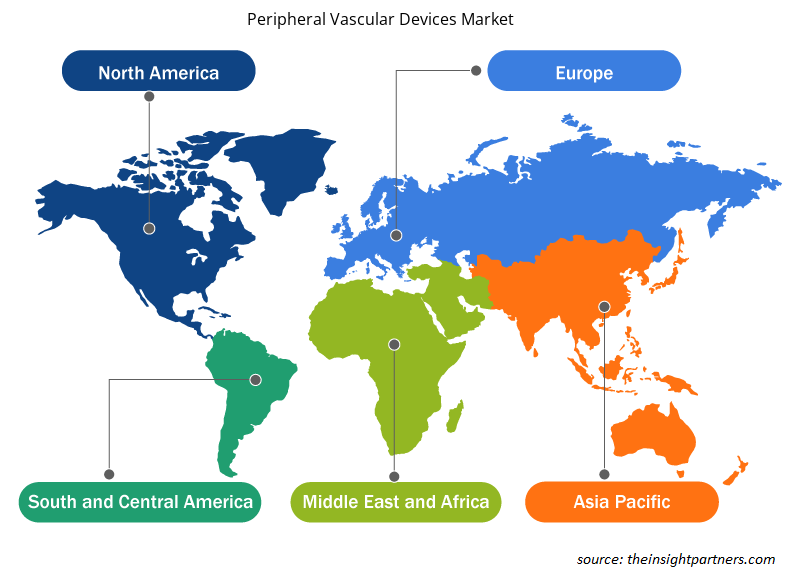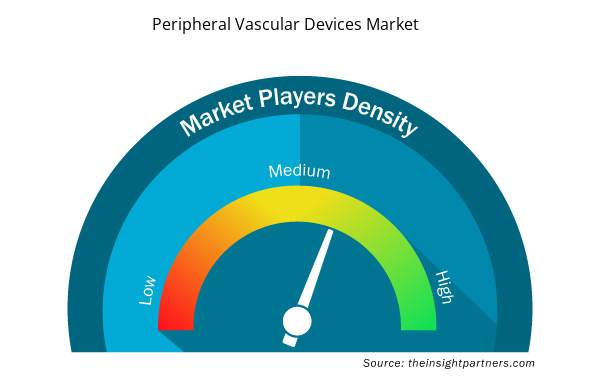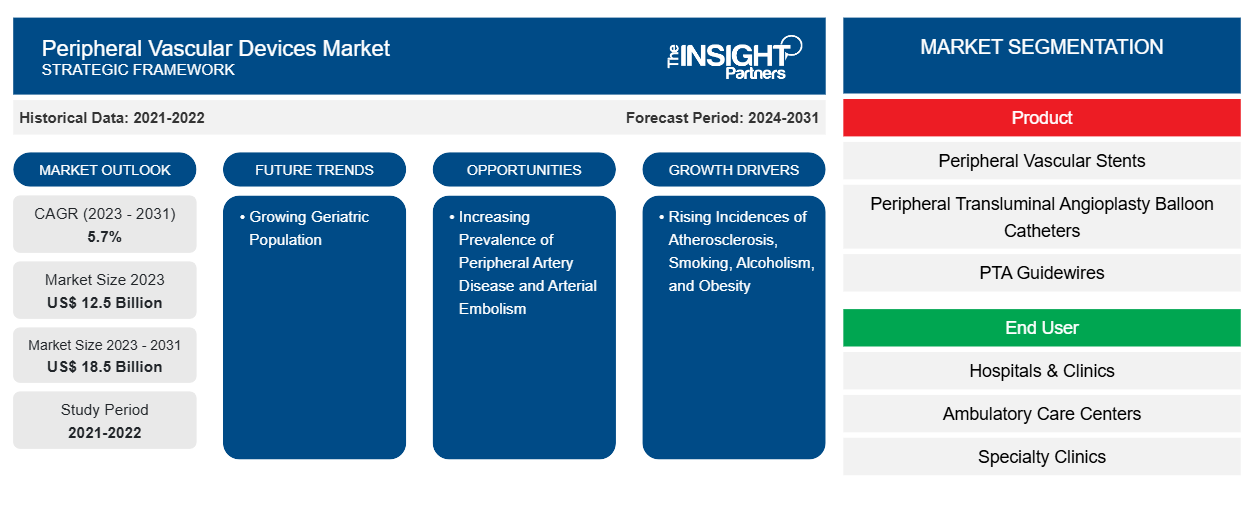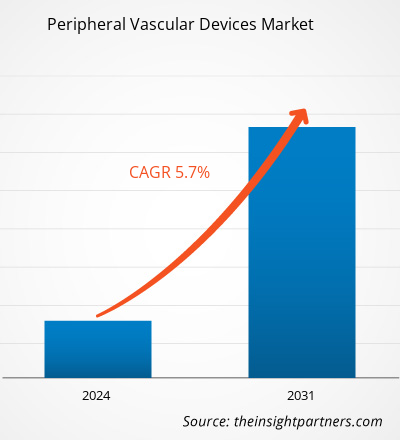Der Markt für periphere Gefäßgeräte soll von 12,5 Milliarden US-Dollar im Jahr 2023 auf 18,5 Milliarden US-Dollar im Jahr 2031 anwachsen. Für den Zeitraum 2023–2031 wird ein durchschnittliches jährliches Wachstum von 5,7 % erwartet. Die medikamentenfreisetzenden Stents und Ballons werden voraussichtlich weiterhin die wichtigsten Trends auf dem Markt bleiben.
Periphere Gefäßgeräte Marktanalyse
Die zunehmende Verbreitung peripherer Gefäßerkrankungen (PVD) ist der Hauptfaktor, der das Marktwachstum antreibt. Laut WebMD leiden 8,5 Millionen Menschen in den Vereinigten Staaten an PVD. PVD tritt vor allem bei Menschen ab 60 Jahren auf und betrifft 12 bis 20 Prozent der Bevölkerung dieser Altersgruppe.
Marktübersicht für periphere Gefäßgeräte
Die zunehmende Verbreitung peripherer Gefäßerkrankungen (PVD), die Zunahme von Erkrankungen wie peripherer arterieller Verschlusskrankheit (PAVK), tiefer Venenthrombose (TVT) und Krampfadern, die zunehmende Überalterung der Bevölkerung, die Entwicklung fortschrittlicher Geräte wie bioresorbierbarer Gefäßgerüste, das wachsende Bewusstsein für periphere Gefäßgeräte, steigende Investitionen in die Gesundheitsinfrastruktur und günstige Erstattungsrichtlinien sind Faktoren, die das Wachstum des Marktes für periphere Gefäßgeräte vorantreiben.
Passen Sie diesen Bericht Ihren Anforderungen an
Sie erhalten kostenlose Anpassungen an jedem Bericht, einschließlich Teilen dieses Berichts oder einer Analyse auf Länderebene, eines Excel-Datenpakets sowie tolle Angebote und Rabatte für Start-ups und Universitäten.
- Holen Sie sich die wichtigsten Markttrends aus diesem Bericht.Dieses KOSTENLOSE Beispiel umfasst eine Datenanalyse von Markttrends bis hin zu Schätzungen und Prognosen.
Markttreiber und Chancen für periphere Gefäßgeräte
Steigende Fälle von Rauchen, Alkoholismus und Fettleibigkeit
Die hohe Prävalenz von Rauchen, Alkoholismus und Fettleibigkeit trägt zur Zunahme peripherer Gefäßerkrankungen bei und erhöht damit die Nachfrage nach peripheren Gefäßgeräten. Laut den Centers for Disease Control and Prevention (CDC) rauchen im Jahr 2021 fast 12 von 100 Erwachsenen in den USA (11,5 %), also etwa 28,3 Millionen Erwachsene in den USA, Zigaretten und über 16 Millionen von ihnen leben mit einer rauchbedingten Krankheit.
Wachsende geriatrische Bevölkerung
Die Inzidenz und Prävalenz peripherer Erkrankungen nimmt mit dem Alter zu. Daher wird die Zunahme der älteren Bevölkerung wahrscheinlich auch die Nachfrage nach peripheren Gefäßgeräten erhöhen. Laut AARP International ist Deutschland eine der fünf „super-gealterten“ Gesellschaften der Welt, und die Zahl der Menschen im Alter von 65 Jahren und älter wird bis 2050 auf 24 Millionen anwachsen, was etwa einem Drittel der Gesamtbevölkerung entspricht.
Segmentierungsanalyse des Marktberichts für periphere Gefäßgeräte
Wichtige Segmente, die zur Ableitung der Marktanalyse für periphere Gefäßgeräte beigetragen haben, sind Produkt und Endbenutzer.
- Der globale Markt für periphere Gefäßgeräte ist nach Produkten segmentiert in periphere Gefäßstents, PTA-Führungsdrähte, Ballonkatheter für periphere transluminale Angioplastie, Atherektomiegeräte, Aortenstents , Geräte für chronische Totalverschlüsse, synthetische chirurgische Transplantate und Embolisationsführungsdrähte. Im Jahr 2023 hielt das Segment der peripheren Gefäßstents den größten Marktanteil, während das Segment der Ballonkatheter für periphere transluminale Angioplastie im Prognosezeitraum voraussichtlich die schnellste CAGR verzeichnen wird.guidewires, peripheral transluminal angioplasty balloon catheters, atherectomy devices, guidewires. In 2023, the peripheral vascular stents segment held the largest share of the market, whereas, the peripheral transluminal angioplasty balloon catheters segment is expected to witness the fastest CAGR during the forecast period.
- In Bezug auf den Endverbraucher wird der Markt in Krankenhäuser und Kliniken, Fachkliniken, ambulante Pflegezentren und andere unterteilt. Im Jahr 2023 hielt das Segment Krankenhäuser und Kliniken den größten Marktanteil und es wird erwartet, dass dasselbe Segment im Prognosezeitraum auch das schnellste Wachstum verzeichnen wird.categorised into hospitals and clinics, specialty clinics, ambulatory care centers, and others. In 2023, the hospitals and clinics segment held the largest share of the market and the same segment is also expected to witness fastest growth during the forecast period.
Periphere Gefäßgeräte Marktanteilsanalyse nach Geografie
Der geografische Umfang des Marktberichts für periphere Gefäßgeräte ist hauptsächlich in fünf Regionen unterteilt: Nordamerika, Asien-Pazifik, Europa, Naher Osten und Afrika sowie Süd- und Mittelamerika.
Der nordamerikanische Markt für periphere Gefäßgeräte ist in die USA, Kanada und Mexiko unterteilt. Die Zunahme peripherer arterieller Erkrankungen und die steigende Nachfrage nach minimalinvasiven Verfahren sind Schlüsselfaktoren, die das Marktwachstum in dieser Region vorantreiben. Darüber hinaus sind Veränderungen des Lebensstils, die zunehmende Alterung der Bevölkerung und technologische Fortschritte einige der wichtigsten Faktoren, die das Marktwachstum in Nordamerika vorantreiben.
Europa hält einen bedeutenden Marktanteil am globalen Markt für periphere Gefäßgeräte. Das Wachstum des Marktes in der Region wird durch die zunehmende Verbreitung peripherer arterieller Erkrankungen, den Anstieg des technologischen Fortschritts und die zunehmende staatliche Unterstützung vorangetrieben.
Regionale Einblicke in den Markt für periphere Gefäßgeräte
Die regionalen Trends und Faktoren, die den Markt für periphere Gefäßgeräte während des Prognosezeitraums beeinflussen, wurden von den Analysten von Insight Partners ausführlich erläutert. In diesem Abschnitt werden auch die Marktsegmente und die Geografie für periphere Gefäßgeräte in Nordamerika, Europa, im asiatisch-pazifischen Raum, im Nahen Osten und Afrika sowie in Süd- und Mittelamerika erörtert.

- Erhalten Sie regionale Daten zum Markt für periphere Gefäßgeräte
Umfang des Marktberichts zu peripheren Gefäßgeräten
| Berichtsattribut | Details |
|---|---|
| Marktgröße im Jahr 2023 | 12,5 Milliarden US-Dollar |
| Marktgröße bis 2031 | 18,5 Milliarden US-Dollar |
| Globale CAGR (2023 - 2031) | 5,7 % |
| Historische Daten | 2021-2022 |
| Prognosezeitraum | 2024–2031 |
| Abgedeckte Segmente | Nach Produkt
|
| Abgedeckte Regionen und Länder | Nordamerika
|
| Marktführer und wichtige Unternehmensprofile |
|
Marktteilnehmerdichte für periphere Gefäßgeräte: Auswirkungen auf die Geschäftsdynamik verstehen
Der Markt für periphere Gefäßgeräte wächst rasant. Dies wird durch die steigende Nachfrage der Endnutzer aufgrund von Faktoren wie sich entwickelnden Verbraucherpräferenzen, technologischen Fortschritten und einem größeren Bewusstsein für die Vorteile des Produkts vorangetrieben. Mit der steigenden Nachfrage erweitern Unternehmen ihr Angebot, entwickeln Innovationen, um die Bedürfnisse der Verbraucher zu erfüllen, und nutzen neue Trends, was das Marktwachstum weiter ankurbelt.
Die Marktteilnehmerdichte bezieht sich auf die Verteilung der Firmen oder Unternehmen, die in einem bestimmten Markt oder einer bestimmten Branche tätig sind. Sie gibt an, wie viele Wettbewerber (Marktteilnehmer) in einem bestimmten Marktraum im Verhältnis zu seiner Größe oder seinem gesamten Marktwert präsent sind.
Die wichtigsten Unternehmen auf dem Markt für periphere Gefäßgeräte sind:
- Abbott
- Edwards Lifesciences Corporation
- Medtronic
- Teleflex Incorporated
- Boston Scientific ist eine gemeinnützige Organisation, die sich auf die Förderung von Wissenschaft und Technologie spezialisiert hat. Sie ist die erste in den USA und hat 19
- BD
Haftungsausschluss : Die oben aufgeführten Unternehmen sind nicht in einer bestimmten Reihenfolge aufgeführt.

- Überblick über die wichtigsten Akteure auf dem Markt für periphere Gefäßgeräte
Marktnachrichten und aktuelle Entwicklungen für periphere Gefäßgeräte
Der Markt für periphere Gefäßgeräte wird durch die Erhebung qualitativer und quantitativer Daten nach Primär- und Sekundärforschung bewertet, die wichtige Unternehmensveröffentlichungen, Verbandsdaten und Datenbanken umfasst. Nachfolgend sind einige der Entwicklungen auf dem Markt für Veterinärdiagnostik aufgeführt:
- Shockwave Medical, Inc., ein Pionier in der Entwicklung der intravaskulären Lithotripsie (IVL) zur Behandlung schwerer kalzifizierter Herz-Kreislauf-Erkrankungen, gab nach der Zulassung durch die US-amerikanische Food and Drug Administration (FDA) die Markteinführung des Shockwave L6 Peripheral IVL Catheter bekannt. (Quelle: Shockwave Medical, Pressemitteilung, März 2023)
- BD startet PAVK-Behandlungsstudie mit gefäßbeschichtetem Stent. (Quelle: BD, Newsletter, März 2024)
Marktbericht zu peripheren Gefäßgeräten – Umfang und Ergebnisse
Der Bericht „Marktgröße und Prognose für periphere Gefäßgeräte (2021–2031)“ bietet eine detaillierte Analyse des Marktes, die die folgenden Bereiche abdeckt:
- Marktgröße und Prognose für Veterinärdiagnostik auf globaler, regionaler und Länderebene für alle wichtigen Marktsegmente, die im Rahmen des Berichts abgedeckt sind
- Markttrends und Marktdynamiken im Bereich Veterinärdiagnostik wie Treiber, Hemmnisse und wichtige Chancen
- Detaillierte PEST/Porters Five Forces- und SWOT-Analyse
- Marktanalyse für Veterinärdiagnostik mit Blick auf wichtige Markttrends, globale und regionale Rahmenbedingungen, wichtige Akteure, Vorschriften und aktuelle Marktentwicklungen
- Branchenlandschaft und Wettbewerbsanalyse, einschließlich Marktkonzentration, Heatmap-Analyse, prominenten Akteuren und aktuellen Entwicklungen auf dem Markt für Veterinärdiagnostik
- Detaillierte Firmenprofile
- Historische Analyse (2 Jahre), Basisjahr, Prognose (7 Jahre) mit CAGR
- PEST- und SWOT-Analyse
- Marktgröße Wert/Volumen – Global, Regional, Land
- Branche und Wettbewerbsumfeld
- Excel-Datensatz



Report Coverage
Revenue forecast, Company Analysis, Industry landscape, Growth factors, and Trends

Segment Covered
This text is related
to segments covered.

Regional Scope
North America, Europe, Asia Pacific, Middle East & Africa, South & Central America

Country Scope
This text is related
to country scope.
Häufig gestellte Fragen
The peripheral vascular devices market is estimated to grow with a CAGR of 5.7% from 2023 to 2031.
The estimated value of the peripheral vascular devices market by 2031 is US$ 18.5 billion
The peripheral vascular devices market majorly consists of the players such as Abbott, Edwards Lifesciences Corporation, Medtronic, Teleflex Incorporated, Boston Scientific Corporation, BD, Cook Medical LLC, Terumo Corporation, B. Braun Melsungen AG, and Cardinal Health Inc. among others
Technological Advancements in Embolization Products and Procedures
Rising incidence of atherosclerosis, smoking, alcoholism, and obesity, coupled with the increasing prevalence of peripheral artery disease and arterial embolism are propelling the market. However, the high costs and complications associated with embolization procedures are hampering the market's growth.
North America dominated the peripheral vascular devices market in 2023
Trends and growth analysis reports related to Life Sciences : READ MORE..
The Insight Partners performs research in 4 major stages: Data Collection & Secondary Research, Primary Research, Data Analysis and Data Triangulation & Final Review.
- Data Collection and Secondary Research:
As a market research and consulting firm operating from a decade, we have published and advised several client across the globe. First step for any study will start with an assessment of currently available data and insights from existing reports. Further, historical and current market information is collected from Investor Presentations, Annual Reports, SEC Filings, etc., and other information related to company’s performance and market positioning are gathered from Paid Databases (Factiva, Hoovers, and Reuters) and various other publications available in public domain.
Several associations trade associates, technical forums, institutes, societies and organization are accessed to gain technical as well as market related insights through their publications such as research papers, blogs and press releases related to the studies are referred to get cues about the market. Further, white papers, journals, magazines, and other news articles published in last 3 years are scrutinized and analyzed to understand the current market trends.
- Primary Research:
The primarily interview analysis comprise of data obtained from industry participants interview and answers to survey questions gathered by in-house primary team.
For primary research, interviews are conducted with industry experts/CEOs/Marketing Managers/VPs/Subject Matter Experts from both demand and supply side to get a 360-degree view of the market. The primary team conducts several interviews based on the complexity of the markets to understand the various market trends and dynamics which makes research more credible and precise.
A typical research interview fulfils the following functions:
- Provides first-hand information on the market size, market trends, growth trends, competitive landscape, and outlook
- Validates and strengthens in-house secondary research findings
- Develops the analysis team’s expertise and market understanding
Primary research involves email interactions and telephone interviews for each market, category, segment, and sub-segment across geographies. The participants who typically take part in such a process include, but are not limited to:
- Industry participants: VPs, business development managers, market intelligence managers and national sales managers
- Outside experts: Valuation experts, research analysts and key opinion leaders specializing in the electronics and semiconductor industry.
Below is the breakup of our primary respondents by company, designation, and region:

Once we receive the confirmation from primary research sources or primary respondents, we finalize the base year market estimation and forecast the data as per the macroeconomic and microeconomic factors assessed during data collection.
- Data Analysis:
Once data is validated through both secondary as well as primary respondents, we finalize the market estimations by hypothesis formulation and factor analysis at regional and country level.
- Macro-Economic Factor Analysis:
We analyse macroeconomic indicators such the gross domestic product (GDP), increase in the demand for goods and services across industries, technological advancement, regional economic growth, governmental policies, the influence of COVID-19, PEST analysis, and other aspects. This analysis aids in setting benchmarks for various nations/regions and approximating market splits. Additionally, the general trend of the aforementioned components aid in determining the market's development possibilities.
- Country Level Data:
Various factors that are especially aligned to the country are taken into account to determine the market size for a certain area and country, including the presence of vendors, such as headquarters and offices, the country's GDP, demand patterns, and industry growth. To comprehend the market dynamics for the nation, a number of growth variables, inhibitors, application areas, and current market trends are researched. The aforementioned elements aid in determining the country's overall market's growth potential.
- Company Profile:
The “Table of Contents” is formulated by listing and analyzing more than 25 - 30 companies operating in the market ecosystem across geographies. However, we profile only 10 companies as a standard practice in our syndicate reports. These 10 companies comprise leading, emerging, and regional players. Nonetheless, our analysis is not restricted to the 10 listed companies, we also analyze other companies present in the market to develop a holistic view and understand the prevailing trends. The “Company Profiles” section in the report covers key facts, business description, products & services, financial information, SWOT analysis, and key developments. The financial information presented is extracted from the annual reports and official documents of the publicly listed companies. Upon collecting the information for the sections of respective companies, we verify them via various primary sources and then compile the data in respective company profiles. The company level information helps us in deriving the base number as well as in forecasting the market size.
- Developing Base Number:
Aggregation of sales statistics (2020-2022) and macro-economic factor, and other secondary and primary research insights are utilized to arrive at base number and related market shares for 2022. The data gaps are identified in this step and relevant market data is analyzed, collected from paid primary interviews or databases. On finalizing the base year market size, forecasts are developed on the basis of macro-economic, industry and market growth factors and company level analysis.
- Data Triangulation and Final Review:
The market findings and base year market size calculations are validated from supply as well as demand side. Demand side validations are based on macro-economic factor analysis and benchmarks for respective regions and countries. In case of supply side validations, revenues of major companies are estimated (in case not available) based on industry benchmark, approximate number of employees, product portfolio, and primary interviews revenues are gathered. Further revenue from target product/service segment is assessed to avoid overshooting of market statistics. In case of heavy deviations between supply and demand side values, all thes steps are repeated to achieve synchronization.
We follow an iterative model, wherein we share our research findings with Subject Matter Experts (SME’s) and Key Opinion Leaders (KOLs) until consensus view of the market is not formulated – this model negates any drastic deviation in the opinions of experts. Only validated and universally acceptable research findings are quoted in our reports.
We have important check points that we use to validate our research findings – which we call – data triangulation, where we validate the information, we generate from secondary sources with primary interviews and then we re-validate with our internal data bases and Subject matter experts. This comprehensive model enables us to deliver high quality, reliable data in shortest possible time.


 Holen Sie sich ein kostenloses Muster für diesen Bericht
Holen Sie sich ein kostenloses Muster für diesen Bericht